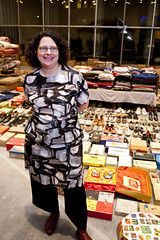The Arts Research Center at UC Berkeley is sponsoring the symposium “Curating People” on April 28 and 29, 2011. Participants have been invited to post some brief thoughts on the topic in advance of the event. This guest posting is by Betti-Sue Hertz, Director of Visual Arts, Yerba Buena Center for the Arts, San Francisco.

Somewhere along the way in the late 1980s things shifted. I was a young visual artist living in a loft in downtown Manhattan where I made my paintings and sculptures, mostly highly charged abstract works. I kept myself on a rather rigorous art-making schedule. During the day, I was curating exhibitions in the South Bronx at a small alternative exhibition space as well as cemeteries and industrial parks. It was this combination that caused the crisis. I was having trouble reconciling my job in one of the poorest districts in the country; my pursuits as a studio artist; and my active social life in the effervescent downtown alternative art scene, even though this was a common enough combination at the time. Its not that these identities couldn’t co-exist, it’s just that it was making me a bit crazy to be shifting between them, often in the course of a single day. After a bit of a meltdown I figured out that this collision of pursuits could converge within my art practice by shifting into a more conceptual and socially engaged type of art. I brought my experiences of the urban street into the studio, moving my art practice into a hybrid of painting, vernacular display art and photo-based documentation. I had just started to research the Puerto Rican casitas that peppered the empty lots in New York City’s Latino neighborhood, and this was the subject of a wall assemblage that was included in Martha Rosler’s If you lived here…1989-90 exhibition at the Dia Art Foundation. It was also the subject of my first major museum show—as a curator—at the Smithsonian Institution on the mall in Washington, D.C. in 1991.
While I may have had the usual doubts about whether I was a good enough artist to really make it, at first I hadn’t necessarily thought that I would seriously take on the role of curator as a full time occupation. But then, after a long while, it started to make sense. Exhibition-making does have its applied creativities as well as a dependence on intuitive gut decisions. Recognizing a pathway of value between works of art, oftentimes, across various artistic voices, coupled with a keen sense of timing and audience, is not without its own challenges. The phasic sequencing of types of work, to achieve the exhibition’s final form, shares importance with a concept of dimensionality. Good art and good art shows both make viewers feel expansive through the integration of a spatial-feeling matrix of physical, emotional, and intellectual attributes. Each exhibition has its own aesthetic challenges, in terms of design and production values, and scholarly occupations. While “making” is at the root of both pursuits, “authorship” feels resolutely different. I still miss the “going deep” part of painting, where, when in the midst of it, time and space disappear as if they both collapse and open up on each other at the same time. By now I’m very comfortable identifying as a curator, but there is still a hole in the center, now filled by other people’s art. Once in a while someone asks me if I miss being an artist. I don’t really, not right now. After all I’m busy working on some very compelling exhibitions at the moment. I usually say, you know, I’d like to go back to it one day.
No comments:
Post a Comment